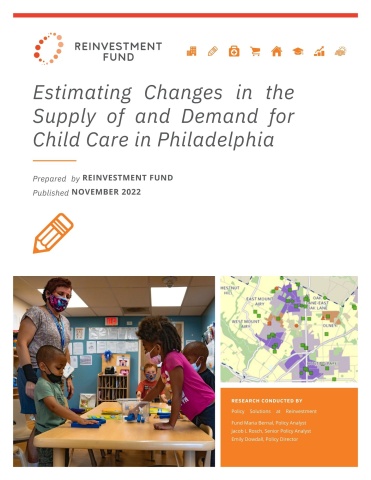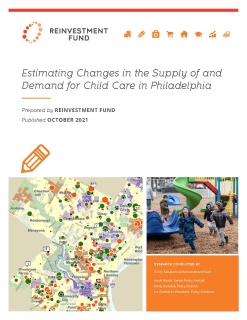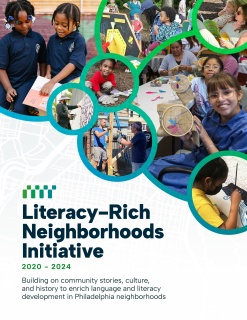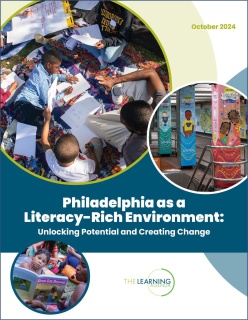Estimating Changes in the Supply of and Demand for Child Care in Philadelphia (2022)

In 2014, with support from The William Penn Foundation, Reinvestment Fund conducted an initial analysis of the supply of and demand for child care in Philadelphia to identify areas of the city where targeted investments could help address shortages of high-quality child care.
In this eighth annual analysis, Reinvestment Fund provides updated estimates that track the change over time in the supply, demand, and shortage of childcare. Reinvestment Fund’s Childcare Map is an interactive online tool (www.childcaremap.org) that showcases the results of this analysis and is accessible to the public at no cost. The tool identifies neighborhoods where high-quality childcare is scarce in absolute and relative terms, while also providing actionable information for funders, practitioners, and childcare advocates.
The estimates presented in this report represent a descriptive and spatial snapshot of the childcare industry in the first quarter of 2022 as the industry navigates its way through the pandemic. It details both short- and long-term changes in the city’s childcare sector, with a special focus on changes brought on by the pandemic from last year (2021) to today (2022). It also tracks shifts since the initial analyses conducted in 2014.
Since the last analysis was published in 2021, Philadelphia has continued to recover from the height of the COVID-19 pandemic and adapt to its lasting presence. March 2022 marked 2 years since the virus caused widespread shutdowns, and in those 24 months people, businesses, and governments saw more change than ever before. Now, firmly in 2022, more employers are calling for their employees to return to downtown offices and public schools have reopened and removed pandemic-era restrictions, like masking and social distancing. A vaccine for children under 5 was finally made available in the summer of 2022, soon after the period captured in this report. More concrete data has emerged on how the childcare industry has adapted to everchanging circumstances. This year’s analysis points to improving conditions across the board. Growth of childcare supply exceeded expectations, acutely observed with the unprecedented expansion of high-quality supply which saw more new high-quality providers participate in the market than ever before. Demand, while still changing along with workplace commuting patterns and new hybrid workplace arrangements, has maintained trends observed in previous analyses.
It is important to note that various factors could have contributed to changes in child case shortages described in this report. For example, demographic shifts and economic changes (e.g., increases in the level of labor force participation) can impact demand for care; operational costs and hiring challenges can affect supply; and new policy initiatives and investments can directly impact gaps. To this last point, this analysis also presents the location of strategic investments made in high-gap areas through the Fund for Quality (FFQ), a partnership between Reinvestment Fund and Public Health Management Corporation (PHMC), with funding from the William Penn Foundation, and Vanguard Strong Start for Kids Program. Through the provision of business planning and facilities-related financing, Fund for Quality supports high-quality early care and education providers with expanding their services to reach more low-income families.


